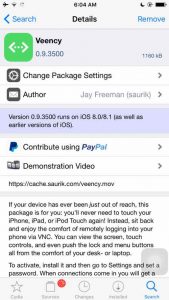

- #Remoter vnc backup config for free
- #Remoter vnc backup config how to
- #Remoter vnc backup config install
- #Remoter vnc backup config manual
- #Remoter vnc backup config full
This cookie is set by GDPR Cookie Consent plugin. These cookies ensure basic functionalities and security features of the website, anonymously. Necessary cookies are absolutely essential for the website to function properly. THANK YOU for all the great instructions!!!!!!!
#Remoter vnc backup config manual
But with the extra instructions in this blog’s main article, you are starting extra services when the machine first boots, so it doesn’t wait for a manual console login. THAT’s why I had to manually login, to start that xserver. OTHER web sites had said to add port 5900 to your firewall and goto :0. Still struggling with the machine changing IP address after every reboot and not registering it’s name with the router, but at least the displays now work with me needing a console login. System -> Administration -> Security Level and Firewall vnc directory)Īlso, in Step # 9 to allow the firewall, in Cent OS 5, it’s slightly different: Then logged in as mbennett and copied /tmp/xstartup to /home/mbennett/.vnc/xstartup (had to mkdir. I copied the fixed up /root/.vnc/xstartup to /tmp On my system it’s root, not admin, and then my username is mbennett on display # 2.Īlso, I was getting a failure on the vncserver restart. Some other minor things on my system (Cent OS 5)
#Remoter vnc backup config full
The popup menus didn’t quite work, and although I would see the hourglass for starting other programs, their window would never come up.īut doing a full Linux reboot DID fix the problem. I also had a problem with a non-root user. Reply to comments 12 and 13 above about NON Root user. Now you will see the desktop as you were log in at the server but now you’re remotely :).
#Remoter vnc backup config for free
Note: You can download VNC Viewer for free at Download VNC® Viewer In this example, I want to remote to Red Hat server as ‘admin’ user which I assign as number 1 in step 6 (1:admin) and my Red Hat server is 10.110.141.220. On my Windows XP computer, open VNC Viewer on Windows XP, type IP Address of Red Hat server with number as a username specify in step 6.
#Remoter vnc backup config how to
In this section, I’ll show how to configure VNC server on Red Hat server and using VNC Viewer connect the server remotely from Windows XP.
#Remoter vnc backup config install
For ultimate simplicity, there is even a Java viewer, so that any desktop can be controlled remotely from within a browser without having to install software.

The two computers don’t even have to be the same type, so for example you can use VNC to view a Windows Vista desktop at the office on a Linux or Mac computer at home. It is remote support software which allows you to view and fully interact with one computer desktop (the “VNC server”) using a simple program (the “VNC viewer”) on another computer desktop anywhere on the Internet. VNC stands for Virtual Network Computing.


 0 kommentar(er)
0 kommentar(er)
